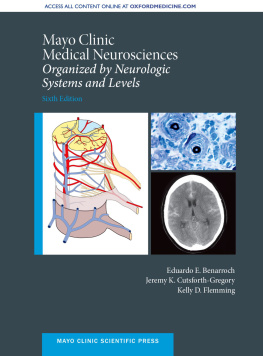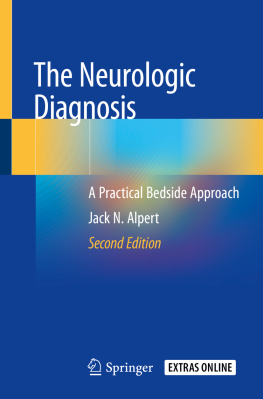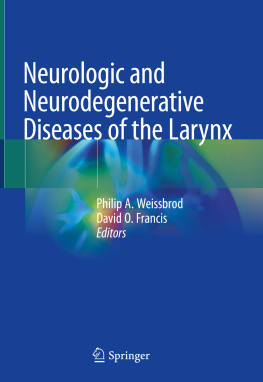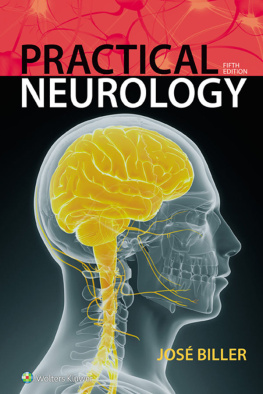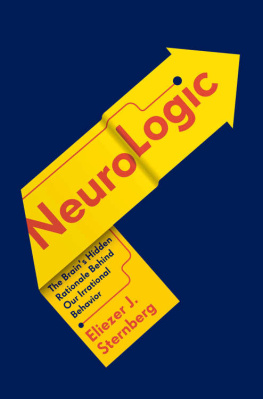Biller Jose - Demyers the Neurologic Examination : A Programmed Text
Here you can read online Biller Jose - Demyers the Neurologic Examination : A Programmed Text full text of the book (entire story) in english for free. Download pdf and epub, get meaning, cover and reviews about this ebook. year: 2016, publisher: McGraw-Hill Global Education, genre: Home and family. Description of the work, (preface) as well as reviews are available. Best literature library LitArk.com created for fans of good reading and offers a wide selection of genres:
Romance novel
Science fiction
Adventure
Detective
Science
History
Home and family
Prose
Art
Politics
Computer
Non-fiction
Religion
Business
Children
Humor
Choose a favorite category and find really read worthwhile books. Enjoy immersion in the world of imagination, feel the emotions of the characters or learn something new for yourself, make an fascinating discovery.
- Book:Demyers the Neurologic Examination : A Programmed Text
- Author:
- Publisher:McGraw-Hill Global Education
- Genre:
- Year:2016
- Rating:4 / 5
- Favourites:Add to favourites
- Your mark:
- 80
- 1
- 2
- 3
- 4
- 5
Demyers the Neurologic Examination : A Programmed Text: summary, description and annotation
We offer to read an annotation, description, summary or preface (depends on what the author of the book "Demyers the Neurologic Examination : A Programmed Text" wrote himself). If you haven't found the necessary information about the book — write in the comments, we will try to find it.
Biller Jose: author's other books
Who wrote Demyers the Neurologic Examination : A Programmed Text? Find out the surname, the name of the author of the book and a list of all author's works by series.
Demyers the Neurologic Examination : A Programmed Text — read online for free the complete book (whole text) full work
Below is the text of the book, divided by pages. System saving the place of the last page read, allows you to conveniently read the book "Demyers the Neurologic Examination : A Programmed Text" online for free, without having to search again every time where you left off. Put a bookmark, and you can go to the page where you finished reading at any time.
Font size:
Interval:
Bookmark:

DeMyers The Neurologic Examination: A Programmed Text, Seventh Edition
Copyright 2017 by McGraw-Hill Education. All rights reserved. Printed in China. Except as permitted under the United States Copyright Act of 1976, no part of this publication may be reproduced or distributed in any form or by any means, or stored in a data base or retrieval system, without the prior written permission of the publisher.
Previous editions copyright 2011, 2004, 1994 by The McGraw-Hill Companies, Inc.
1 2 3 4 5 6 7 8 9 DSS 21 20 19 18 17 16
ISBN 978-0-07-184161-0
MHID 0-07-184161-X
eISBN 978-0-07-184162-7
eMHID 0-07-184162-8
Notice
Medicine is an ever-changing science. As new research and clinical experience broaden our knowledge, changes in treatment and drug therapy are required. The authors and the publisher of this work have checked with sources believed to be reliable in their efforts to provide information that is complete and generally in accord with the standards accepted at the time of publication. However, in view of the possibility of human error or changes in medical sciences, neither the authors nor the publisher nor any other party who has been involved in the preparation or publication of this work warrants that the information contained herein is in every respect accurate or complete, and they disclaim all responsibility for any errors or omissions or for the results obtained from use of the information contained in this work. Readers are encouraged to confirm the information contained herein with other sources. For example and in particular, readers are advised to check the product information sheet included in the package of each drug they plan to administer to be certain that the information contained in this work is accurate and that changes have not been made in the recommended dose or in the contraindications for administration. This recommendation is of particular importance in connection with new or infrequently used drugs.
This book was set in Minion Pro by Cenveo Publisher Services.
The editors were Andrew Moyer and Regina Y. Brown.
The production supervisor was Catherine H. Saggese.
Project management was provided by Anupriya Tyagi, Cenveo Publisher Services.
RR Donnelley was printer and binder.
This book is printed on acid-free paper.
Catalog-in-Publication Data is on file for this title at the Library of Congress.
McGraw-Hill books are available at special quantity discounts to use as premiums and sales promotions, or for use in corporate training programs. To contact a representative please visit the Contact Us pages at www.mhprofessional.com.
This is the seventh edition of Dr. DeMyers textbook on The Neurologic Examination. It is the second under the stewardship of the current authors. When first published in 1994, Dr. DeMyer hoped it would fill a gap and function as a self-learning tool that combined with feedback from experienced clinicians and practice at the bedside, would improve the diagnostic skills of a student. It was never meant to be read, but in many respects it was a to-do book. It was the active doing or practicing the techniques that Dr. DeMyer felt would engage the student and facilitate learning rather than promote memorization. As bedside examination skills improve, ultimately patients would come to benefit.
Currently there is a tendency to undermine the benefits of the physical examination as a foundational skill in clinical diagnosis. Various explanations are given that include limitations of time, increased sensitivity of diagnostic tools or the fact that some physical examination skills or findings, have been shown to not be diagnostic at all. It is certainly true that there are some physical examination practices of only historical interest, but most of the skills in eliciting a history and a relevant physical examination remain critical to proper diagnosis. When properly performed, they provide valuable information to an underlying disease and interpretation of abnormal diagnostic test results often relies on physical examination findings. Finally, the physical examination is of enormous benefit in the effective use of these diagnostic tests and the elimination of unnecessary ones. So, far from being relegated to historical interest, these skills are as important in the development of a clinician as they are for the patients under their care.
We want to end this preface by again acknowledging Dr. William E. DeMyer as an esteemed colleague who demonstrated the highest qualities of a physician, master clinician, and teacher. The origin of this book, and the current authors intention, is to promote the value of a thoughtful physical examination and interpretation of those findings. We hope this book will fill such a role by becoming a virtual mentor that facilitates learning, through performing and interpreting physical examination findings. If the directions within this book are followed, not only will you benefit, but so will your patients and that is an ultimate responsibility that society expects of us. We hope you enjoy this excursion and we wish you the best as your careers unfold.
Jos Biller, MD
Gregory Gruener, MD
Paul W. Brazis, MD
The purpose of this textbook is threefold: (1) to teach how to conduct a neurologic examination, (2) to review the anatomy and physiology for interpreting the examination, and (3) to show which laboratory tests help to clarify the clinical problem. This is not a differential diagnosis text or a systematic description of diseases.
Anyone who sets out to write a textbook should place the manuscript on one knee and a student on the other. When the student squirms, sighs, or gives a wrong answer, the author has erred. He should correct it right then, before the ink dries. That is the way I have written this text, on the basis of feedback from the students.
The peril of student-on-the-knee teaching is that, even though the student moves his lips, the words and voice remain the teachers. To escape from ventriloquism, my text relies strongly on self-observation and induction. First, you learn to observe yourself, not as Narcissus, but as a sample of every man. Whenever possible, you study living flesh, its look, its feel, and its responses. Why study a textbook picture to learn the range of ocular movements when you can hold up a hand mirror? Why memorize the laws of diplopia if you can do a simple experiment on yourself whenever you need to refresh your memory? In the best tradition of science, these techniques supplant the printed word as the source of knowledge. The text becomes a way of extending your own perceptions, of looking at the world through the eyes of experience.
Because programmed instruction is the best way for the learner to judge whether learning has taken place, most of the text is programmed. The student is not abandoned to guess whether he has learned something; the program makes him prove that he has. Programming, if abused or overdone, becomes incredibly dull and unmercifully slow. The reader is required to inspect each grain of sand but should have been shown the whole shoreline at a glance. Some programs err by bristling with objectivity, causing one to ask, Isnt there a human being around here somewhere? Didnt someone think this, decide it, maybe even guess at it a little? For interludes, I use quotations, anecdotes, and poetry. I even stoop to mnemonics. Sometimes I cajole without pretending, as is customary in textbooks, that the pages have been purified, relieved of an author. I am very much here, poking my head out of a paragraph now and then or peering at you through an asterisk. When I see that you are weary from filling in blanks, I offer some whimsy. When you overflow with something to say, I ask for an essay answer. Sometimes you are invited to anticipate the text, to match wits against the problem without the spoon. At all times as you practice the neurologic examination, I stand at your elbow, guiding your moves and interpretations. You should be able to do an accomplished neurologic examination when you finish the book. And lastly, I include references. Only one reader in a hundred uses them? I am interested in him, too, in his precious curiosity.
Font size:
Interval:
Bookmark:
Similar books «Demyers the Neurologic Examination : A Programmed Text»
Look at similar books to Demyers the Neurologic Examination : A Programmed Text. We have selected literature similar in name and meaning in the hope of providing readers with more options to find new, interesting, not yet read works.
Discussion, reviews of the book Demyers the Neurologic Examination : A Programmed Text and just readers' own opinions. Leave your comments, write what you think about the work, its meaning or the main characters. Specify what exactly you liked and what you didn't like, and why you think so.





